Summer is the season for sea breezes in the Bay Area, and no one knows that better than the kite-boarders, windsurfers, and sailors who ply the Bay every chance they get.

Sign up for our free weekly newsletter and understand everything better!


Summer is the season for sea breezes in the Bay Area, and no one knows that better than the kite-boarders, windsurfers, and sailors who ply the Bay every chance they get.
-150x150.jpg)
How the heck do all those ants find you every time you sit down at a park for a nice picnic? The short answer is: sheer numbers and good communication. But there’s a lot more to know about ants than that…

Q: Rumor has it there might have been a waterfall at the Golden Gate during the last ice age, when sea level was at its lowest. Is there any evidence for this? [Cisco, Oakland] A: Well, there is no incontrovertible … Read more
-150x150.jpg)
Despite the fog, we still think of summer as beach season here in the Bay Area. And that’s one thing we have in common with the western snowy plover, a small bird that needs a lot of help to brave the crowds on San Francisco’s beaches. Volunteering to watch, walk, and talk for the snowy plover at Ocean Beach or Crissy Field may be just right for you.
-150x150.jpg)
Every day, millions of people drive over it on a half dozen bridges. Ferries and freighters cross it. Windsurfers and kayakers and boaters ply its waters. It’s the picture-postcard backdrop for thousands of tourists along the San Francisco waterfront. And yet much of the real action in San Francisco Bay is hidden from us beneath murky waters. A new plan aims to change that…
-150x150.jpg)
The Gulf of the Farallones National Marine Sanctuary, along with its sister sanctuaries to the north and south, Cordell Banks and Monterey Bay, are sentinels for the effects of global warming on ocean waters. And, as documented in a new report released, Central California’s offshore waters and coastline are already showing the effects of global warming.
-150x150.jpg)
A team of artists has collected more than 1,000 recordings of people sharing their thoughts about the oceans. Hear voices from from scientists and schoolchildren, people in the United States, Europe, Asia. A sound collage from the collection premieres at Cal Academy on June 3.
-150x150.jpg)
Artists, naturalists, and National Parks officials come together to create a remarkable new exhibit of installation art made for “animal clients,” open at the Presidio from May 16, 2010, though May 15, 2011.
-150x150.jpg)
At the western edge of the Delta lies a most unexpected gathering of wildlife. Here peregrines hunt from tall towers, beavers lodge in protected waters, and hummingbirds nest in the least likely of spots. What was once among the busiest, noisiest, smelliest, most crowded, most unsafe places to earn the name “habitat” has become a haven for dozens of species.
-150x150.jpg)
Imagine raising your kids on a precarious bunch of sticks on a tree branch. Some birds had the same thought: Yikes! These cavity-nesters take shelter by excavating nest holes in trees, or by using existing holes–in trees, cliffs, buildings, bridges, tractors…